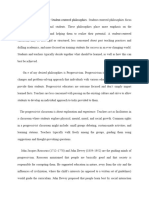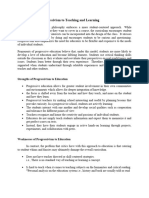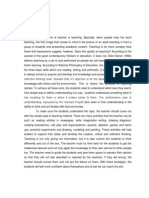Theories of Education - Lacay, Rose Amor M.
Theories of Education - Lacay, Rose Amor M.
Uploaded by
Rose Amor LacayCopyright:
Available Formats
Theories of Education - Lacay, Rose Amor M.
Theories of Education - Lacay, Rose Amor M.
Uploaded by
Rose Amor LacayOriginal Title
Copyright
Available Formats
Share this document
Did you find this document useful?
Is this content inappropriate?
Copyright:
Available Formats
Theories of Education - Lacay, Rose Amor M.
Theories of Education - Lacay, Rose Amor M.
Uploaded by
Rose Amor LacayCopyright:
Available Formats
THEORIES OF EDUCATION AND THEIR APPLICATION
TO CLASSROOM SETTING
SOCIAL RECONSTRUCTIONISM
In the educational philosophy of social reconstructionism, learning happens on
both affective and psychomotor experiences. It focuses on students being able to hold
discussions on controversial issues by developing strategies on how to deal with them
and understanding that there are multiple perspective and beliefs on each topic
discussed. These affective experiences result in a variety of learning taking place,
including increasing one’s perspectives in inquiry, dialogue, and multiple perspectives
through learning about other people’s opinions.
This follows student-centered setting wherein teachers act merely as a
facilitator, not as an instructor during class discussions and activities. When the
instruction is placed on the students, they become active participants in the learning,
oftentimes through doing, which results in psychomotor experiences (Social
Reconstructionism). Allowing the students to create their own classroom rules is an
example of student-centered teaching which would then encourage the reconstruction
of society through education. It should be every educator’s goal to provide students
with the resources and the ability to live successful lives where they can work to
change the injustices that so many marginalized people face. Teaching students to
have the belief that they can make changes to society can be very hard to do, but
allowing them to create the rules of the classroom will help them gain the confidence
to do so. When students are able to collaborate and make their own classroom rules,
they feel as if they can be powerful people who can use their voice to make a change.
When students feel like their voice is important, they will be more inclined to use them
to make changes to society which is the goal of social reconstructionism.
As a facilitator of discussions, teachers need to teach their students a multitude
of viewpoints on varying issues so they are able to create their own beliefs on issues,
thereby guiding them on the process. Focusing on social injustices on the curriculum
of this philosophy, the students need to begin learning how to form opinions on their
own and having discussions on topics where all viewpoints are included where they
are required to respect each other’s opinion. This skill can begin at a young age as it
is one all people will need throughout their lives.
PROGRESSIVISM
Progressivism educational philosophy is where teachers believe that each
child is unique and will learn individually based on what is significant for that
person's life to know and understand. As a progressivist teacher, they will guide and
coach in the classroom. As it gives more importance to experience rather than formal
learning which concentrates on developing the child’s talents, the teacher will have a
lot of group work to have the students work together to find curiosity and feed off
what one already knows. The students interact with one another and develop social
qualities such as cooperation and tolerance for different points of view. The teacher
will also be able to tend to children more one on one, allowing time to help each
child meet their own needs. This type of environment promotes curiosity, fun, and
is a safe place for children to explore their own minds without being told they are
wrong. Another thing about a progressivist teacher is that they use a lot of real life
examples as they are preparing children for the "real world." In addition, students
solve problems in the classroom similar to those they will encounter in their everyday
lives.
As the progressivist classroom is about exploration and experience, teachers act
as facilitators where students actively learning to explore physical, mental, moral, and
social growth. Common sights in a progressivist classroom may include: small groups
debating, custom-made activities and learning stations.
There are five steps to create a progressive, student-centered classroom:
1. Create ongoing projects. The ongoing project plays an essential role in
promoting mastery.
2. Integrate technology.
3. Replace homework with engaging in-class activities.
4. Eliminate rules and consequences.
5. Involve students in evaluation
You might also like
- Five Educational Learning TheoriesDocument4 pagesFive Educational Learning TheoriesKim Rose Borres100% (1)
- Delm112-Social, Psychological, and Philosophical Issues in EducationDocument10 pagesDelm112-Social, Psychological, and Philosophical Issues in EducationSonny Matias100% (3)
- 2001 Sturtevant A History of GeneticsDocument179 pages2001 Sturtevant A History of Geneticsmabru_blackNo ratings yet
- Philosphophy PaperDocument5 pagesPhilosphophy Paperapi-479463379No ratings yet
- Madison Njusts Teaching PhilosophyDocument3 pagesMadison Njusts Teaching Philosophyapi-610245464No ratings yet
- Educational TheoriesDocument8 pagesEducational TheoriesLyza CredoNo ratings yet
- A Reflection On The Philosophies of EducationDocument5 pagesA Reflection On The Philosophies of EducationJohn Philip Wilson Marteja100% (1)
- How Teachers Can Promote Social Change in The ClassroomDocument2 pagesHow Teachers Can Promote Social Change in The Classroomabdullatif rodeniNo ratings yet
- My Philosophy of Teaching 050314Document5 pagesMy Philosophy of Teaching 050314api-252669940No ratings yet
- Philophy of Education - Rebeca BarbaDocument5 pagesPhilophy of Education - Rebeca Barbaapi-336587367No ratings yet
- Journal EntryDocument4 pagesJournal EntryLimuel CaringalNo ratings yet
- Educational TheoryDocument4 pagesEducational TheoryShimaa SorourNo ratings yet
- Importance of Pilosophies For Teachers PDFDocument1 pageImportance of Pilosophies For Teachers PDFDjan Clerick MoradaNo ratings yet
- PhilosophyDocument3 pagesPhilosophyapi-305769748No ratings yet
- Philosophies of EducationDocument6 pagesPhilosophies of EducationBob FloresNo ratings yet
- Belief StatementDocument5 pagesBelief Statementapi-288345162No ratings yet
- Teaching PhylosophyDocument3 pagesTeaching PhylosophyNashKlasikNasrahMihatNo ratings yet
- Article 1 - Learing TheoriesDocument5 pagesArticle 1 - Learing TheoriesKavitha AlwisNo ratings yet
- Essay On How Can I Be A Progressivist TeacherDocument5 pagesEssay On How Can I Be A Progressivist TeacherJun Cueva Comeros100% (1)
- Why I Want To Be A TeacherDocument3 pagesWhy I Want To Be A Teacherapi-392714774No ratings yet
- Philosophy of EducationDocument9 pagesPhilosophy of Educationapi-350129925No ratings yet
- Philosophy of EducationDocument5 pagesPhilosophy of Educationapi-562371166No ratings yet
- Educational PhilosophiesDocument20 pagesEducational PhilosophiesSharonNo ratings yet
- Running Head: Philosophy of Education 1Document9 pagesRunning Head: Philosophy of Education 1dcupplesedtechNo ratings yet
- Educational PhilosophiesDocument19 pagesEducational PhilosophiesSharonNo ratings yet
- Service Learning ReflectionDocument9 pagesService Learning Reflectionapi-317166571No ratings yet
- Curriculum Development First Milestone İlayda-Zeynep-Öykü-BartuDocument3 pagesCurriculum Development First Milestone İlayda-Zeynep-Öykü-BartutanktufekNo ratings yet
- Philosophy of EducationDocument9 pagesPhilosophy of Educationapi-285312776No ratings yet
- Educational PhilosophyDocument5 pagesEducational Philosophyapi-354424723No ratings yet
- Philosophy of EducationDocument7 pagesPhilosophy of Educationapi-288966220No ratings yet
- Teaching PhilosophyDocument2 pagesTeaching Philosophyapi-311326994No ratings yet
- Implications ProgDocument6 pagesImplications ProgperezmilkyabegailNo ratings yet
- Quezada Keila Cuin 6301 Research Paper Rough DraftDocument11 pagesQuezada Keila Cuin 6301 Research Paper Rough Draftapi-466109761No ratings yet
- My Philosophy of EducationDocument3 pagesMy Philosophy of EducationVillamor Lanas Jhon LloydNo ratings yet
- Constructivism TheoryDocument4 pagesConstructivism TheoryBrittney D MinahalNo ratings yet
- Philosophy of EducationDocument4 pagesPhilosophy of Educationapi-309856914No ratings yet
- Philosophies of EducationDocument3 pagesPhilosophies of EducationCute PororoNo ratings yet
- Moral EducationDocument5 pagesMoral EducationJessy SNo ratings yet
- Reflection ESSENTIALISMDocument3 pagesReflection ESSENTIALISMNemfa Tumacder100% (14)
- Edu 1010 Chapter 5Document2 pagesEdu 1010 Chapter 5api-260363728No ratings yet
- Phylosophy of EducationDocument7 pagesPhylosophy of Educationencisn32100% (1)
- Model Instructional MamaDocument28 pagesModel Instructional MamaAbraham ZakariaNo ratings yet
- My Philosophy On EducationDocument3 pagesMy Philosophy On Educationapi-236602178100% (1)
- Role of TeacherDocument17 pagesRole of TeacherKhairunnisa Sharom100% (1)
- Curriculum Development First Milestone İlayda-Zeynep-Öykü-BartuDocument3 pagesCurriculum Development First Milestone İlayda-Zeynep-Öykü-BartutanktufekNo ratings yet
- Critical PedagogyDocument5 pagesCritical PedagogyMisbah TahirNo ratings yet
- Adult Learning TheoryDocument11 pagesAdult Learning TheoryKuna 96100% (1)
- Ehp5043 Teaching Phylosophy ShazwanDocument5 pagesEhp5043 Teaching Phylosophy Shazwankl2207011574No ratings yet
- Lesson 3: My Personal Philosophy of Education Capture (Preparation) : Videoke TimeDocument6 pagesLesson 3: My Personal Philosophy of Education Capture (Preparation) : Videoke TimeArlene Culagbang GuitguitinNo ratings yet
- Educational Philosophy Final Paper Digital PortfolioDocument6 pagesEducational Philosophy Final Paper Digital Portfolioapi-406658477100% (1)
- Reconstructionism and ProgressivismDocument2 pagesReconstructionism and ProgressivismMike Lyster AlvarezNo ratings yet
- My Educational PhilosophyDocument6 pagesMy Educational Philosophyapi-218061588No ratings yet
- Curriculum Development 6Document9 pagesCurriculum Development 6Teacher SallyNo ratings yet
- Advanced PedagogyDocument5 pagesAdvanced PedagogyRahul Sharma100% (3)
- A-VED 311-Requirements For Midterm - Mrs. Condeza PDFDocument15 pagesA-VED 311-Requirements For Midterm - Mrs. Condeza PDFgenelyn gunoNo ratings yet
- PhilosophyDocument6 pagesPhilosophyapi-5811714090% (1)
- Sib AssignmentDocument7 pagesSib Assignmentapi-415905015No ratings yet
- Assessment 2 Critical Personal Reflection Luke Ranieri 17698506Document3 pagesAssessment 2 Critical Personal Reflection Luke Ranieri 17698506api-486580157No ratings yet
- Philosophy of EducationDocument25 pagesPhilosophy of Educationmariaflorina91No ratings yet
- Classroom-Ready Resources for Student-Centered Learning: Basic Teaching Strategies for Fostering Student Ownership, Agency, and Engagement in K–6 ClassroomsFrom EverandClassroom-Ready Resources for Student-Centered Learning: Basic Teaching Strategies for Fostering Student Ownership, Agency, and Engagement in K–6 ClassroomsNo ratings yet
- How To Be a Great Teacher: Your Step-By-Step Guide To Teach Students EffectivelyFrom EverandHow To Be a Great Teacher: Your Step-By-Step Guide To Teach Students EffectivelyNo ratings yet
- Film Production Job RolesDocument11 pagesFilm Production Job RolesMatthew McMillan100% (1)
- Learn Coding Basics in Hours With Python An Introduction To Computer Programming For Absolute BegiDocument127 pagesLearn Coding Basics in Hours With Python An Introduction To Computer Programming For Absolute BegiKabir WestNo ratings yet
- Tinnezia Istiqomah 1807016056 Uas Pengembangandiri PengaruhghostingterhadapinterpesonalDocument7 pagesTinnezia Istiqomah 1807016056 Uas Pengembangandiri Pengaruhghostingterhadapinterpesonalilene agustineNo ratings yet
- Structuring Decisions and Making Choices IDocument57 pagesStructuring Decisions and Making Choices IJoli SmithNo ratings yet
- Amsar A European Active Antenna Radar Programme: P.Lacomme" R. Gotz B. GB - Fisher H.HommelDocument6 pagesAmsar A European Active Antenna Radar Programme: P.Lacomme" R. Gotz B. GB - Fisher H.HommelAnnisa SalsabellaNo ratings yet
- Stack Trace 2024.10.04 19-30-17.580Document3 pagesStack Trace 2024.10.04 19-30-17.580bousseradjkadiroNo ratings yet
- Two-Phase Induction MachinesDocument15 pagesTwo-Phase Induction MachinesHania DogarNo ratings yet
- Bell Palsy: Nelson Textbook of Pediatrics 19 EditionDocument11 pagesBell Palsy: Nelson Textbook of Pediatrics 19 EditionTommy YauNo ratings yet
- Úvod Do Studia Jazyka - L1Document8 pagesÚvod Do Studia Jazyka - L1Roberto DevereuxNo ratings yet
- Micro Small Medium Enterprises Sector in India: A Way ForwardDocument8 pagesMicro Small Medium Enterprises Sector in India: A Way ForwardMadhwendra SinghNo ratings yet
- Siddaganga Institute of Technology, TumkurDocument4 pagesSiddaganga Institute of Technology, TumkurNiranjan DsNo ratings yet
- Placement ReportDocument12 pagesPlacement Reportsnehadixit596No ratings yet
- Lead Practice Nurse - BirminghamDocument3 pagesLead Practice Nurse - BirminghamM LubisNo ratings yet
- Lab Centre of Pressure Ecw341Document4 pagesLab Centre of Pressure Ecw341danialNo ratings yet
- Catalog 2012Document34 pagesCatalog 2012Razi AhmadNo ratings yet
- Ba 2Document11 pagesBa 2Owen BauerNo ratings yet
- Non Metallic MaterialDocument10 pagesNon Metallic MaterialVinoth Rengaraj100% (1)
- 15-01-2019 Sample Paper Assistant Director at ErDocument9 pages15-01-2019 Sample Paper Assistant Director at ErBilal WarisNo ratings yet
- Proposal Letter For ParentsDocument4 pagesProposal Letter For ParentsAndrea CardenNo ratings yet
- 6T30 6T40Document8 pages6T30 6T40Fabiano Silva AzechiNo ratings yet
- Cat C175-16 - Jul 2010Document6 pagesCat C175-16 - Jul 2010Lei YinNo ratings yet
- For Students Quantifiers and ProofsDocument33 pagesFor Students Quantifiers and ProofsJohn Carlo Sinampaga Solivio-LisondatoNo ratings yet
- 3 Five R'sDocument7 pages3 Five R'sJoNo ratings yet
- Direct Instruction Lesson Siana BergDocument2 pagesDirect Instruction Lesson Siana Bergapi-488045418No ratings yet
- Sample Questions:: Section I: Subjective QuestionsDocument8 pagesSample Questions:: Section I: Subjective QuestionsAll NNo ratings yet
- Wind Response of Cable-Stayed Masts: July 2005Document9 pagesWind Response of Cable-Stayed Masts: July 2005Homer SilvaNo ratings yet
- Gapps Networking GuideDocument42 pagesGapps Networking GuideYusuf MohamedNo ratings yet
- TK2153 Information Sharing Tutorial 3Document3 pagesTK2153 Information Sharing Tutorial 3MimiNo ratings yet
- Topic 1-Understanding The Supply Chain Management IssuesDocument47 pagesTopic 1-Understanding The Supply Chain Management IssueszkillerszNo ratings yet

























































































